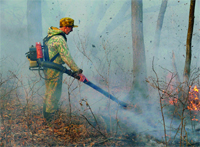
Features
Training
Trainer’s Corner: Interface decision making
As the number of people moving into the scenic wildlands increases, so does the probability of wildland fires posing some threat to homes and other structures. Wildfire plays an important role in our forests and grasslands. It recycles nutrients by clearing out accumulated dead vegetation, thins tree stands and cracks seed casings, thereby creating a diverse wildlife habitat. So, like it or not, living in forested areas means living with fire.
April 28, 2008
By Ed Brouwer
 As the number of people moving into the scenic wildlands increases, so does the probability of wildland fires posing some threat to homes and other structures. Wildfire plays an important role in our forests and grasslands. It recycles nutrients by clearing out accumulated dead vegetation, thins tree stands and cracks seed casings, thereby creating a diverse wildlife habitat. So, like it or not, living in forested areas means living with fire.
As the number of people moving into the scenic wildlands increases, so does the probability of wildland fires posing some threat to homes and other structures. Wildfire plays an important role in our forests and grasslands. It recycles nutrients by clearing out accumulated dead vegetation, thins tree stands and cracks seed casings, thereby creating a diverse wildlife habitat. So, like it or not, living in forested areas means living with fire.
Most firefighting methods deal with fire that starts inside and burns out whereas a wildland fire starts on the outside and tries to get in. Fire needs fuel to burn and a continuous sequence of vegetation can carry flames from the forest to a structure. We can help prevent this by placing a defensible space around the structure.
Few, indeed, are the wildfires today that don’t threaten something. We will never have enough fire apparatus or personnel to set up in front of everybody’s homes. Increasing firefighting services may help, yet in the extreme conditions posed by a wildland urban interface fire there never seems to be enough.
 |
| The 2003 fire season in British Columbia was a clear example of the complexity of what can happen when wildfires turn into urban challenges. |
The 2003 fire season that ravaged British Columbia is a clear example of the complexity of protecting the wildland urban interface. There were three firefighter fatalities, 335 homes lost or damaged, 38,009 people evacuated and 148,695 hectares lost to fire.
When dealing with interface fires consider the following:
Before deploying, assure that all personnel are in full protective equipment, all water tanks are full, all engines have adequate fuel and all radios work.
When water conservation is important, don’t wet down ahead of fire, extinguish only what is absolutely necessary. When possible, coat structures with foam or gel.
Let everything burn that is not vital to fire control or not an exposure hazard to objects of value. (What is burned up can’t re-ignite.) Our fire crews have had to leave hose lines at a fast-moving fire. Should this happen to you, take the fittings with your apparatus if possible.
Survey ahead of fire and give priority of protection considering construction type, topographical factors, availability of equipment and personnel and the rate of fire spread. Do not waste time and energy on structures that will be lost no matter what effort you expend.
Company officers, strike team leaders, division supervisors, and operations section chiefs must be capable of making one of the most difficult decisions on a wildland fire: which houses to try to save, and which ones to write off. This is called structure triage. As cold as this may seem, firefighters must see structures as “fuel.” This can be especially difficult when the house is owned by another firefighter, family or friend. Stay focused: eliminate the hopeless; ignore the unnecessary; and deal with the rest.
Much as a medic would assess mass casualties on the battlefield, efforts must be concentrated on those that stand a reasonable chance. It is a given that not everyone will survive. Those who are essentially hopeless will be passed over in order to save those that can be saved with the time and resources available.
This philosophy applies to houses exactly as it does to victims. If firefighters do not stand a reasonable chance of saving the house, they must move on to the next house. (See sidebar, below.)
STRUCTURE TRIAGE Each structure is triaged (sized-up) in terms of its susceptibility to ignition and the resources needed to defend it. • Structure needs little or no protection for now. • Structure needs protection but can be saved. • Structure is hopeless and cannot be saved. Trying to save indefensible structures may spread the available resources too thin, resulting in the loss of those that could have been defended. Outbuildings are generally not included in this triage decision. Outbuildings will The following are typical structural/wildland (interface) physical characteristics that may cause problems for the firefighter. 1. Type of construction. (The most vulnerable part of structure is the roof.) |
Keep in mind that if fire conditions change and become more severe after a triage decision has been made, an otherwise defensible home may no longer be savable. Strong winds can overcome positive factors in the above list. Our fire crew saw first-hand the adverse effect of high winds at the Okanagan Mountain Park fire in 2003, as we fought hotspots up to 2.4 kilometres ahead of the fire front.
In many cases the most important factor will be the slope of the ground where a home is situated and the direction the fire is moving. Fires usually move faster up hill due to convection and radiation preheating the fuels.
The most important consideration is safety. Can your crews safely defend the structure? Are adequate safety zones and escape routes available and accessible?
Warning: If fire threatens your escape route, abandon all structures and get out.
You may want to prepare for a practice night regarding structure protection and triage by taking photographs of area homes that can be used to illustrate the three priorities of structure triage. Show clear-cut examples of homes that need little protection – homes that would probably survive with extra protection and those that probably would not survive even if protection resources were available.
Fire conditions can change quickly (a wind change, fire spotting, equipment malfunction) to the point that the battle is no longer winnable. The bottom line is that the structure must be abandoned if further efforts place firefighters in harm’s way.
It is time to retreat to a safer place when:
Spot fires are occurring on roofs or around the structure more rapidly than they can be extinguished.
Fire ignites the roof and involves more than one-quarter of it in windy conditions.
Fire ignites an interior room in windy conditions.
The escape route is about to be blocked.
Resource: III Edition Fundamentals of Wildland Fire Fighting, S-100 Basic Fire Suppression & Safety Student Work Book, National Wildland/Urban Interface Fire Program
Ed Brouwer is the chief instructor for Canwest Fire in Osoyoos, B.C., and the training officer for West Boundary Highway Rescue. The 18-year veteran of the fire service is also a fire warden with the B.C. Ministry of Forests, a first responder, level III, instructor/evaluator and fire-service chaplan. E-mail: ed@thefire.ca
Print this page
Advertisement
- Lessons learned: On-the-job training, experience necessary to become well-rounded firefighter
- Truck Checks: More transmission tips